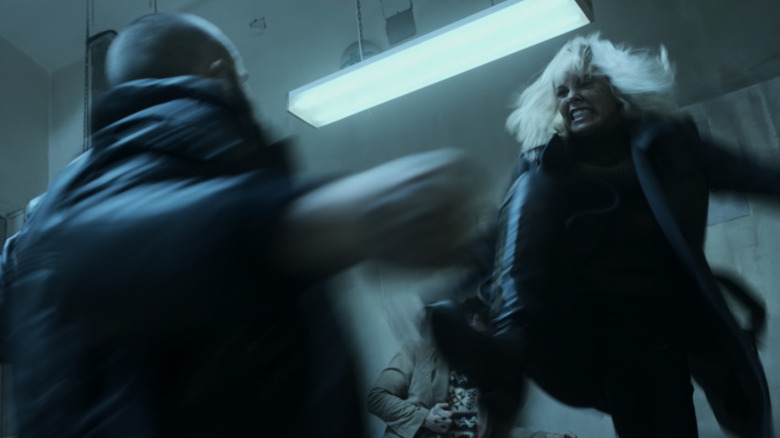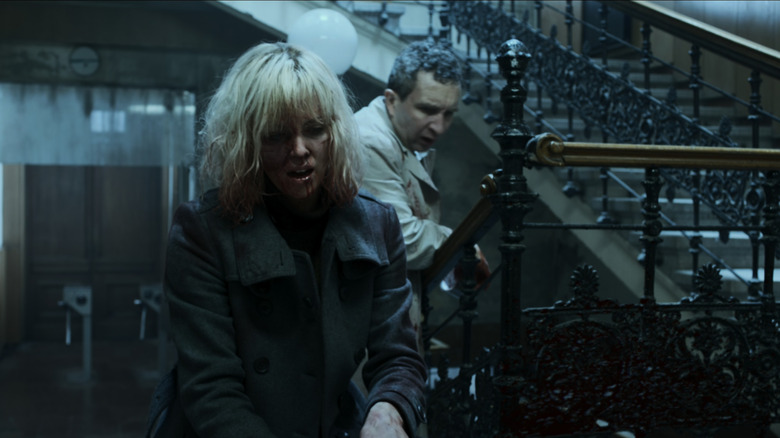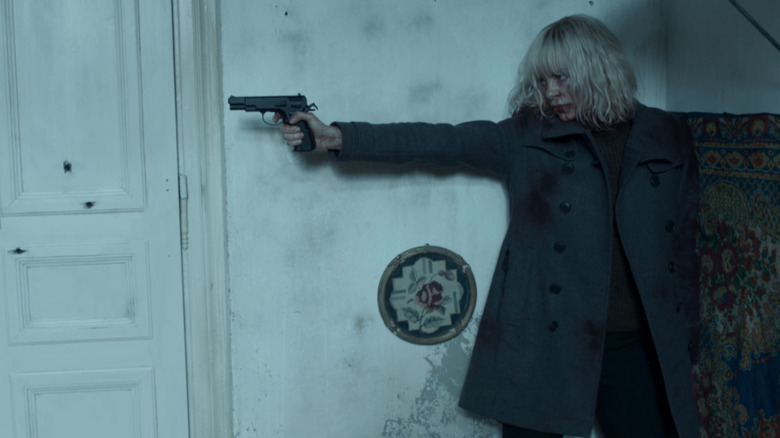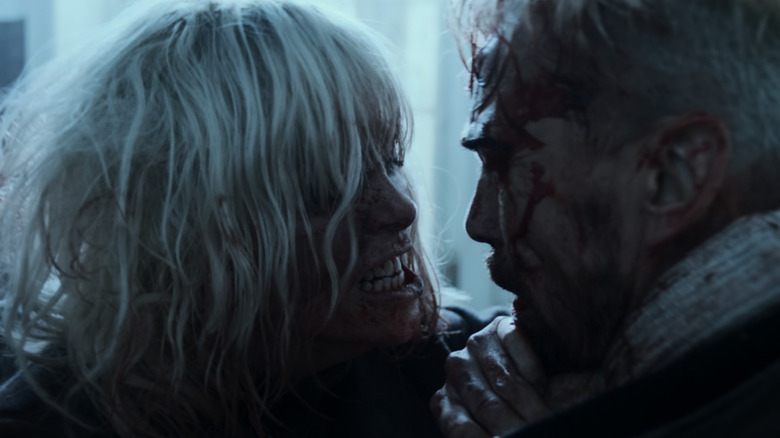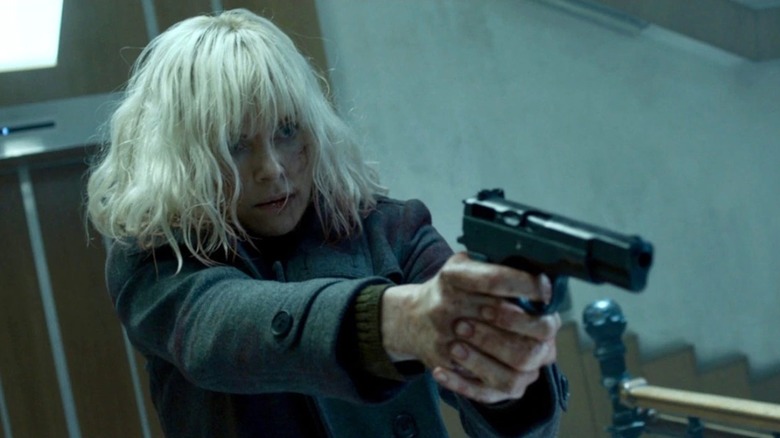How Atomic Blonde's Amazing Stairwell Fight Came Together
Whether as an actor, stuntman, or director, David Leitch has been the architect behind some of the most captivating recent fight scenes in film. His catalog of work spans some of the biggest action movies of the last twenty years, including the last two films in "The Matrix Trilogy," "300," and "Deadpool 2."Although it was in Leitch's directorial debut, "John Wick," where he developed his signature for boldly executed action sequences that both captivate and drive the plot forward, he perfected his process on his second project, "Atomic Blonde."
One scene stands out in particular: the brutal 10-minute stairwell fight Charlize Theron's character, MI6 agent Lorraine Broughton, engages in near the end of the film. Inspired by the stitched-together long takes of Alfonso Cuarón's "Children of Men," Leitch admitted in a GQ interview he'd long had the idea to do something similar, but had never been able to implement it.
After Theron bought the rights to the graphic novel "Atomic Blonde" would be based on, the actress approached Leitch to direct. He realized this was his chance to finally nab the white whale of his career. But filming the stairwell fight sequence would prove to be exceptionally demanding. For Leitch and those responsible for editing, there were logistical hurdles to be overcome while Theron and the stunt actors needed to give realistically gritty and visceral performances without getting too injured.
Charlize Theron surpassed Leitch's expectations
Theron as Broughton is of course the linchpin of the entire stairwell fight — which means not only did she need to be able to do a lot of those stunts herself, she had to memorize the complicated choreography. Speaking with Vanity Fair, Leitch explained that she underwent an intense six weeks of training, four to five days a week to prepare for the role of Broughton.
It wasn't long before the director realized he'd struck gold with Theron as his lead. He told Business Insider that he started getting "remote videos from L.A." and with every update on her training, he realized he'd finally found an actor who might be able to pull off the kind of extended take he'd always dreamed of doing. It also helped that Theron had been a trained dancer in her youth. "Fight choreography has far more in common with dance choreography than it does with actual martial arts," Leitch told GQ. "You learn martial arts techniques but those are just the movements for the choreography," he said. "You're working with a partner in choreography. You're working on timing. Having the dance background was invaluable."
Of course, successfully getting Theron and the stunt actors to nail the choreography was one thing. Doing it all without anyone getting seriously injured, or worse yet, putting your lead out of commission, was another challenge entirely.
Dodging injuries and knowing when to use stunt doubles
With Leitch's abundance of experience filming and being a part of scenes like the stairwell fight, he recognized injuries are inevitable — but they can be greatly mitigated. The director went into detail with GQ about all the things that can go wrong at any moment that might lead to some kind of injury:
"You're doing all these reactions with your neck and your neck is thrown out of wack. You're blocking the stunt performers and there are bruises on your forearm. You are missing a punch and you hit the matte box of the camera. She did bend her fingers back and there are bruises on her forearm. She knee slides and misses her knee pad and then you've got swelling on your knee. Even when you're being safe, eight hours of choreography makes you look like you've been through a war. It's hard. It's like playing hockey for eight hours."
Because of the grueling toll, Leitch strategically chose when to use Theron's stunt double Monique Ganderton. Take for instance the moment Broughton is thrown down the stairs near the beginning of the fight. That's actually Ganderton doing the roll, but Theron who gets slammed into the wall — so even when she had a double she was still taking hits. "She would do both," Leitch admits. "But you had to keep shooting and you couldn't risk that type of injury."
So instead they just used the motion blur of Ganderton's fall to hide the switch to Theron. After all, there's really no point in risking your actor for stunts that audiences can't even tell it's them for. Which makes sense given there's so much in the 10-minute sequence that benefits from us seeing Theron herself fighting.
Creating the scene's progressive special effects
Leitch's whole purpose for wanting to shoot the stairwell scene was to see if he could forward the film's plot throughout all the action. A small but vitally important piece of that meant that if this was going to be 10-minutes of real-time fighting, there needed to be a way to illustrate the effect on each character.
Leitch told GQ that Theron gave a mandate for all the action in the film to be "real and have consequences." The director continued:
"I wanted to show consequential action. You fight long, you get tired. You get hit in the face, you get a black eye. There's blood in your mouth. Special effects make-up would come in and we had it all broken out, the different levels of damage for each stitch. We were constantly adding as we progressed. We shot the fight in continuity."
In a lot of ways, the entire stairwell action scene is a battle of attrition between Broughton and her attackers. As she fights, she takes blows that start to degrade her ability to defend herself and attack. But the same happens to her assailants — albeit far more quickly and fatally than for Broughton. The upside to this attention to detail is a potent sense of realism that also heightens the stakes. Not only do you hear every blow that Theron's character takes but you also can see it: the blood, the glass, the way she struggles to get her balance, and her increased reliance on anything she can get her hands on to use as a weapon. And as the desperation of Theron and her attackers grow the anxiety keeps you glued to the edge of your seat.
Leitch got crafty with the edits and hidden cuts
The final piece of the puzzle for Leitch after the choreography and special effects was figuring out how to edit and slyly cut the stairwell scene. His plan was to use hidden cuts that would allow them to stitch the scenes together, creating the illusion of a continuous shot. Luckily Leitch had the same talented editor who worked with him on "John Wick" and his latest film "Bullet Traim," Elísabet Ronaldsdóttir.
In that same Vanity Fair video, the director even points out each of the hidden cuts. But don't go thinking this somehow made the whole ordeal easier — it just made logistical sense. "It involved using a lot of old-school camera tricks — pans, wipes, body-crossings — that allowed us editorially to have breaks, to choose between takes, but so it would never feel like we cut out," he explained to GQ. "But the pieces we stitched together were really long, some as long as two minutes."
And even then the actors had to do multiple takes of each stitch, which were shot chronologically over four days. When you watch the full sequence though it's pretty much impossible to find any sort of hiccup with the cuts seamless as they are. It's a perfect example of just how much editing can affect the way we experience a scene — especially one as kinetic and dynamic as the "Atomic Blonde" stairwell fight.
